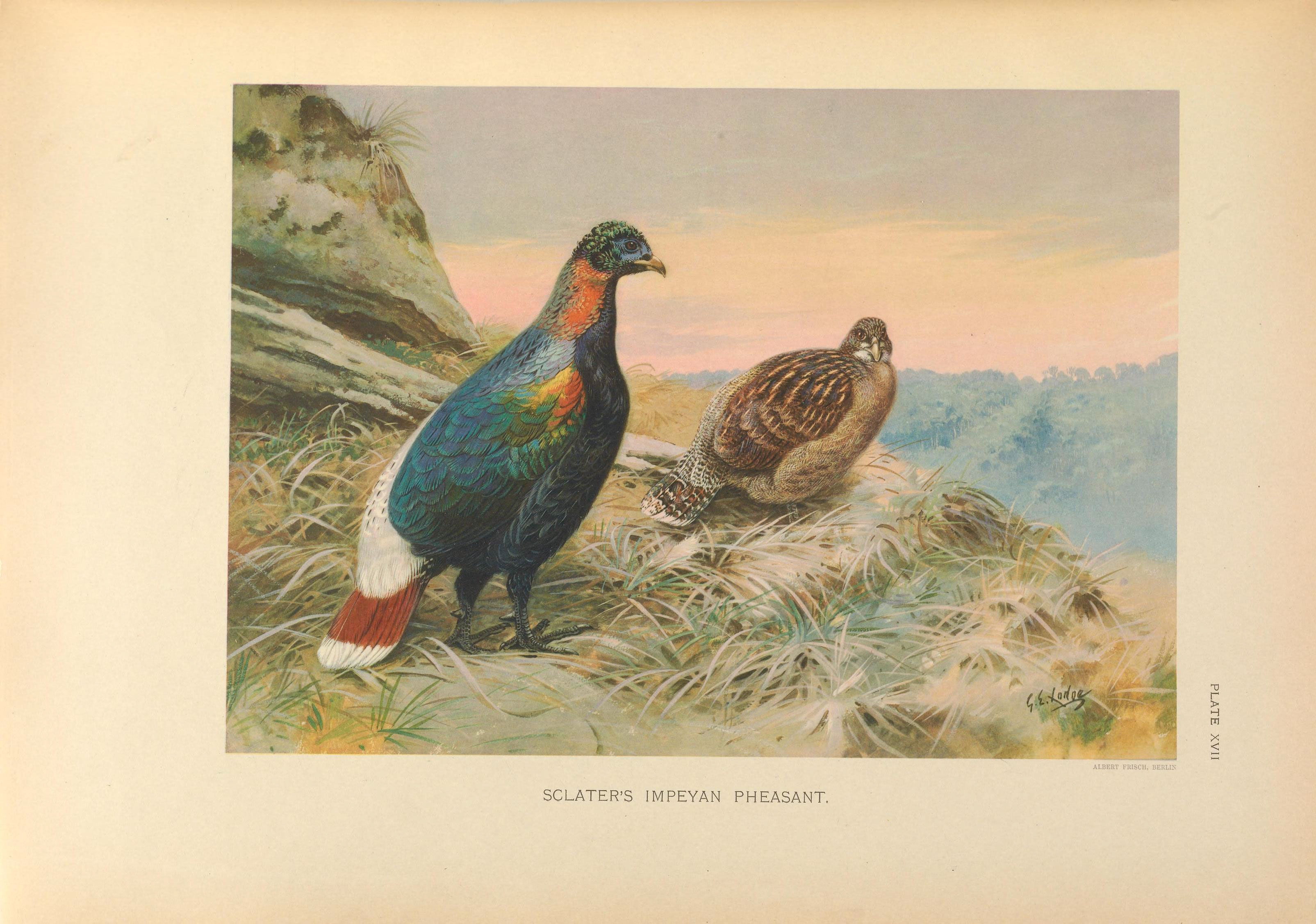| Citation |
|
Description |
Geographic Range [top]
Range Description: Lophophorus sclateri is endemic to the eastern Himalayas, from Arunachal Pradesh, India, east through northern Myanmar and south-eastern Tibet to western Yunnan, China. There are recent records from Arunachal Pradesh, where it is locally fairly common, Yunnan, where numbers are thought to be stable, and Myanmar (J. C. Eames verbally 2003), where it was historically described as local and uncommon.
Countries occurrence:
Native:
China; India; Myanmar
Additional data:
? Continuing decline in area of occupancy (AOO): Unknown
? Extreme fluctuations in area of occupancy (AOO): No ? Estimated extent of occurrence (EOO) - km2: 45500
? Continuing decline in extent of occurrence (EOO): Unknown ? Extreme fluctuations in extent of occurrence (EOO): No
? Number of Locations: 11-100 ? Continuing decline in number of locations: Unknown
? Extreme fluctuations in the number of locations: No ? Lower elevation limit (metres): 3000
? Upper elevation limit (metres): 4200
Range Map: Click here to open the map viewer and explore range.
Population [top]
Population: The population is estimated to number 2,500-9,999 mature individuals based on an assessment of known records, descriptions of abundance and range size. This is consistent with recorded population density estimates for congeners or close relatives with a similar body size, and the fact that only a proportion of the estimated Extent of Occurrence is likely to be occupied. This estimate is equivalent to 3,750-14,999 individuals, rounded here to 3,500-15,000 individuals.
Trend Justification: The species is suspected to be declining at a moderate rate, principally as a result of hunting pressure and habitat loss.
Current Population Trend: Decreasing
Additional data:
? Number of mature individuals: 2500-9999 ? Continuing decline of mature individuals: Yes
? Extreme fluctuations: No ? Population severely fragmented: Yes
? No. of subpopulations: 5-100 ? Continuing decline in subpopulations: Unknown
? Extreme fluctuations in subpopulations: No ? All individuals in one subpopulation: No
? No. of individuals in largest subpopulation: 1-89
Habitat and Ecology [top]
Habitat and Ecology: It inhabits alpine meadows, subalpine rhododendron scrub and rocky precipitous slopes from 3,000-4,200 m, occurring down to the edge of oak-rhododendron (S. Kumar in litt. 2004) and coniferous forest with a bamboo understorey, azalea forest, and areas of juniper and cotoneaster, descending to temperate forest at 2,000-3,000 m in October (Suresh and Singh 2004). Where its range overlaps with L. impejanus, it generally occurs at higher altitudes although some local reports have described them occurring together (S. Kumar in litt. 2004). It is solitary during the breeding season (spring), but gregarious in winter. It feeds on roots, tubers, seeds, bark and leaf parts (Suresh and Singh 2004).
Systems: Terrestrial
Continuing decline in area, extent and/or quality of habitat: Yes
Generation Length (years): 5.2
Movement patterns: Altitudinal Migrant
Threats [top]
Major Threat(s): Hunting for food is the single main threat across the speciess range. In addition, hunting for feathers (to make ornaments and fans) is a localised problem in India. In the Arbor Hills (S. Kumar in litt. 2004) and Mishmi Hills, India, hunting intensity has significantly reduced population densities. Habitat degradation as a result of logging is a more localised threat. The habitats of the newly discovered taxon in Arunachal Pradesh appear to be little threatened, owing to their inaccessibility.
Conservation Actions [top]
Conservation Actions: Conservation Actions Underway
CITES Appendix I. It is legally protected in India (A. Rahmani in litt. 2012). It occurs in the Gaoligong Shan National Nature Reserve in Yunnan, China, although it appears to be rare here and numbers are probably small (Han Lianxian in litt. 2004). The creation of Dehang-Debang Biosphere Reserve in Arunachal Pradesh, which encompasses the Dibang Valley Wildlife Sanctuary, Mouling National Park and unclassified state forests, offers further protection (S. Kumar in litt. 2004). The remote nature of its habitats and range, to an extent, lessen the level of threat it faces from hunting. In 1997, the Endangered Species Breeding Centre of Beijing received three pairs to begin a captive breeding programme, although the subsequent outcome is unknown. Success has however been enjoyed by similar programmes for related species (BirdLife International 2001). A new subspecies was recently described and its conservation status has been reviewed (Suresh and Singh 2004).
Conservation Actions Proposed
Conduct further surveys in Yunnan, south-east Tibet and Arunachal Pradesh to determine its population status and range. Carry out detailed studies to assess its habitat preferences and principal threats. Campaign for protected areas in Towang, West Kameng, East Kameng and Lower Subansiri districts, Arunachal Pradesh. Assess the contribution of the protected area network to its conservation and develop appropriate management/policy recommendations. Monitor poaching and survey wildlife markets throughout its range to determine the scale and socioeconomic importance of hunting; appoint security personnel to control this threat, and carefully control the issuing of gun licences. Begin a conservation education programme in Arunachal Pradesh (A. Rahmani in litt. 2012). Follow up the establishment of a captive breeding programme and potentially extend this further.
Citation: BirdLife International. 2013. Lophophorus sclateri. The IUCN Red List of Threatened Species 2013: e.T22679185A48036013. http://dx.doi.org/10.2305/IUCN.UK.2013-2.RLTS.T22679185A48036013.en. Downloaded on 09 August 2016.
Disclaimer: To make use of this information, please check the .
Feedback: If you see any errors or have any questions or suggestions on what is shown on this page, please provide us with feedback so that we can correct or extend the information provided
|


